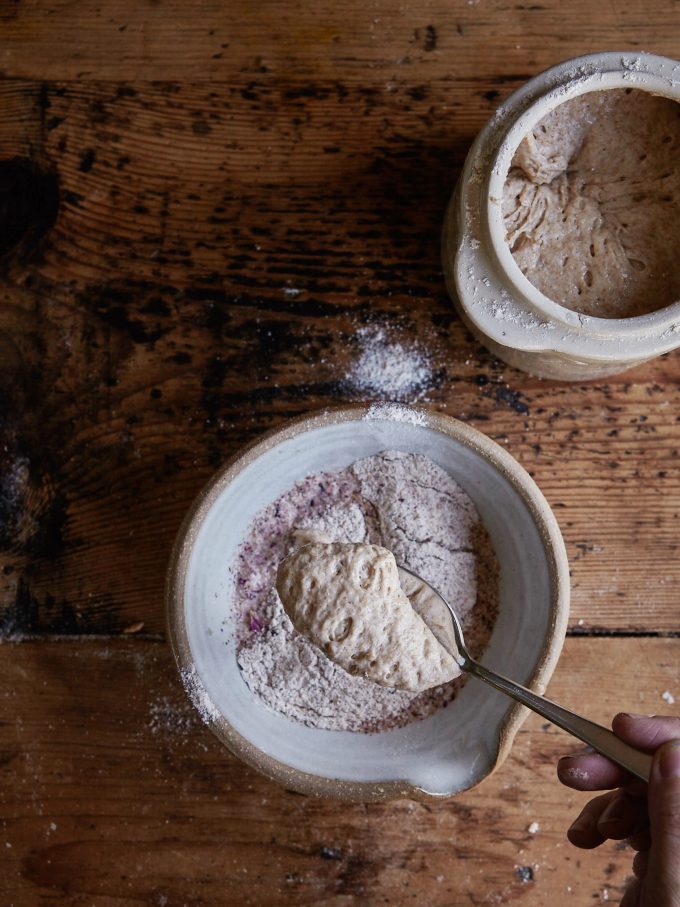 As water mixes with flour and your starter your dough takes life, quite literally. You have introduced, wild yeast, to a gang of 3 or 4 lactic acid bacteria (LAB), and to a substrate of flour, which also has its own part to play.
As water mixes with flour and your starter your dough takes life, quite literally. You have introduced, wild yeast, to a gang of 3 or 4 lactic acid bacteria (LAB), and to a substrate of flour, which also has its own part to play.
There are quite literally multiple changes that are set off all at once, and as the baker you are the conductor. It is your actions that determine the rate and outcome of the process through your temperature, hydration and management of your yeast and bacteria populations by the way that you refresh your starter. You control the rate of acidity, and in turn this controls the rate at which the enzymes (that cut everything up and play a central role in the process) break down the flour.
In the very first moments water brings together two proteins, that form gluten but perhaps the most important part of the process is in the activation of the enzymes.
Possibly a better way to understand sourdough is that bacteria are single-celled organisms and, lacking stomachs, they use enzymes to break down their food on the outside – in the dough. And while there are about 160 known species of yeast, they divide into 2 groups Saccharomyces and non-Saccharomyces.
Think of this as though it were a fruit, Saccharomyces cerevisiae, commonly known as baker’s yeast, (think of this as being apples) and the one most often found in bakeries, and within this there are many different strains, (in the same way as you would get granny smiths or brambly or crab apples). They are fairly simple in their needs, they fermentable sugars, amino acids, vitamins, minerals and also oxygen a key component in the bakers control. Yeast are quite versatile and happily ferment a high spectrum of sugars, including glucose, fructose, sucrose, maltose, all of which can be found both in ripe fruit but also in cereals. In addition, yeasts tolerate acidic environments with pH values around 3.5 or even less, which makes hanging out with Lactic acid bacteria a game changer for bakers as they have developed a symbiotic relationship which we nurture in a pot with flour and water and call a starter.
Each yeast cell can bud 20-30 times during its life, on each occasion producing an identical new cell called a daughter that can make the same number of new cells again. In the right condition’s multiplication can be very fast, and a teaspoon of starter culture can grow to 150 tons in just a week = the equivalent to a blue whale.
Why is the flour key to the rate of fermentation?
The kind flour that you use is one of the key things you need to understand when it comes to the speed of fermentation of your dough. A flour’s enzyme levels will depend on where in the world it was grown. British flours for example tend to have high levels of naturally occurring enzymes because they are grown in a maritime environment. This results in high levels of enzyme activity. The key enzyme that leads the way is called amylase, so high levels of amylase means that dough ferments more quickly and the yeasts are more active, and more carbon dioxide is produced, making the bread bouncier and more voluptuous. You will sometimes find flours that have had enzymes added to them – flours from the USA, for example, tend to have less naturally occurring enzymes so millers make adjustments using malt and alpha-amylase to get the liveliness and activity needed.
Enzymes – there are quite a few at work as follows:
- Diastase/Amylase – under the right conditions, diastase will break up some starch, liquefy it, and convert it into malt sugar.
- Protease – found in flour, but also in malt and yeast.
- Maltase.
- Invertase.
- Zymase – an enzyme complex that yeast catalyses the fermentation of sugar into ethanol and carbon dioxide.
So, amylase converts starch to dextrin’s, oligosaccharides, and the sugar maltose, and as amylases break the starch into smaller molecules, it ultimately yields maltose, which in turn is cleaved into two glucose molecules – ie sugar. Yeast do really well transforming simple sugars because they have a simple chemical structure, making them easy to break down.
So, do yeast excrete amylase? Yes, amylases are found naturally in yeast cells, however it takes time for the yeast to produce enough to break down significant quantities of starch in the bread, so the naturally occurring amylase in flour plays an important role in breaking down the starch into sugars.
Is this why some flours ferment faster than others?
Yes. Essentially increasing the level of amylases in the dough, increases the quantities of sugars available for the yeast fermentation, accelerating the production of CO2. This explains why some flours ferment faster than others. A flour that is sprouted is a good example of this. The real purpose of the enzymes is to give food to the new baby plant, but of course, we just ground this plant into flour, however it doesn’t know this. Effectively all the component parts of the seed, behave as though it landed in some soil. When you understand this then it all makes sense. Flour is behaving like a seed that is growing and the enzymes are there to feed the plant. The yeast is very happy to find all this food and amylases love water. So, this is one of the reasons why doughs with a higher hydrations ferment faster—the amylases (and other enzymes) can literally move about and cut up the starch faster. So, the sugar is made quicker, and the yeast get to eat up faster and produce CO2 quicker. When yeast breaks down glucose, it transforms it into carbon dioxide and ethanol, both by-products are formed in equal parts. So, for every glucose molecule, two molecules of carbon dioxide and two molecules of ethanol are formed. This is aerobic respiration (funnily enough the same process we humans use).
The yeast also produces ethanol as well as CO2 waste products, which in turn inflate the gluten that formed.
Breaking down the gluten.
The reality is that gluten was a 2nd or even 3rd meal for the plant. So, the enzymes that are key to breaking down the gluten are called proteases and they cleave (break in into bits) the peptide bond in, and the result is amino acids that the yeast love. These were of course originally intended for the baby plant.
For the baker the results are that they decrease mixing times by increasing the speed of water absorption, which in turn then increases dough extensibility but also reduces the dough consistency.
This sequence of breakdown is integral for the flavour development and influences volatile compound profile. The amino acids from the proteins in gluten, for example, interact via the Maillard reaction with any remaining glucose, resulting in the really delicious flavour components of both crust and colour in sourdough. These processes are particularly slow and one of the reasons why artisan bread has more flavour than fast bread or fake sourdough.
Alcoholic fermentation is a also a biochemical process in progress as the sugars such as the glucose, fructose, and sucrose are converted into small amounts of ATP, producing ethanol and carbon dioxide during the process.
At room temperature, the alcohol is liquid, but when the bread hits the oven, the alcohol begins to evaporate, transforming into gas bubbles that contribute to the rise of your bread. Given the amount of alcohol formed during fermentation, of course ethanol helps bread rise.
Amazing flavour
What is amazing about sourdough is its complexity. There are over 300 identified volatile organic compounds belonging to different chemical classes. The Lactic acid bacteria produce both lactic and acetic acid, and the yeasts can produce metabolites that specifically affect flavour, including organic acids ( 14) diacetyl, branched-chain amino acids, as well as aldehydes ( 43) ketones ( 19) alcohols, , and sulphide compounds, that form (over 30) esters during fermentation and baking (Beuhler, 2006). Yeasted bread simply does not have the same complexity. Using only yeasts in wheat bread, seven volatiles were found abundant: acetaldehyde, acetone, ethyl acetate, ethanol, hexanal, isobutyl alcohol, and propanol.
However, scientists tend to note that alcohols, produced by the yeast, and acids by the LAB and aldehydes represent the most characteristic volatile compound families that influence the aroma and flavour in sourdough. It is fair to say that the balance of these compounds are impacted by the different approaches to your starter and your flour and the way you ferment your sourdough will certainly influence the aromatic profile of bread. Colder proof times will bring forward the heterofermentative bacteria, and high levels of titratable acids which have a deeper level of acidity, releasing more proteolytic enzymes and more free amino acid resulting in a more complex flavoured retarded bread than say in comparison to the ambient method generally favoured by the French.
Generally, though it is agreed that the activity of the yeasts and LAB, the enzymatic activity, and thermal reaction all make a difference to your bread, but you can say that the flavours of bread crumb is influenced mainly by the enzymatic reactions during dough fermentation and that the flavour of bread crust is more influenced by thermal reactions during the baking process. This is called the carbonyl-amine reactions or Maillard reaction and is essentially the caramelization of sugars giving your bread that classic burnished copper and mahogany look and of course the amazing flavours.
Featured Shop Products
-

Membership with Beginners Sourdough Baking Kit
£85.00 Buy from our stockist -

Membership with Sourdough Boule Baking Kit ( Intermediate)
£99.00 Buy from our stockist -
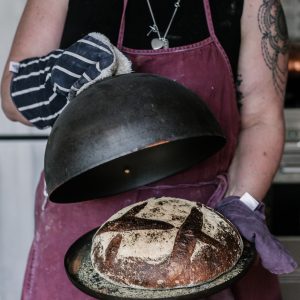
Membership ON SALE – Reduced joining fee from £299 On sale for £99
£9.99 / month after an initial 1 month period for £99.00 including joining fee Join Now

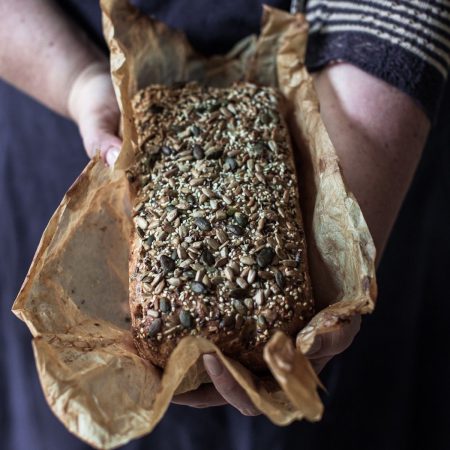
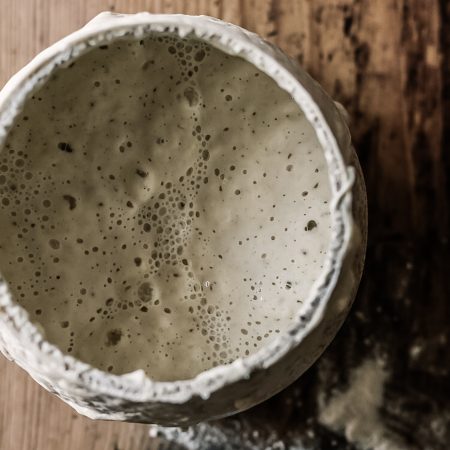
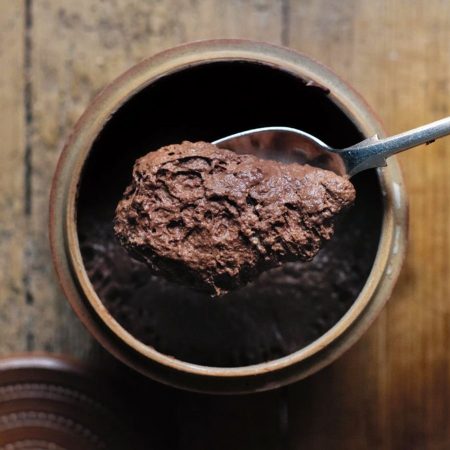
Leave a Reply